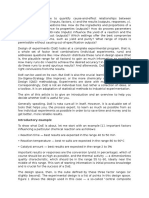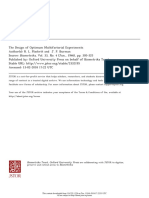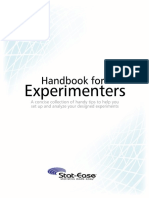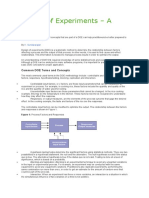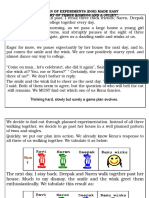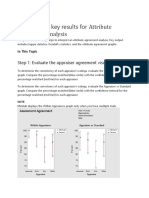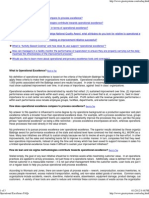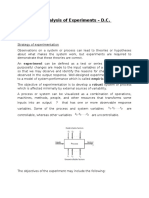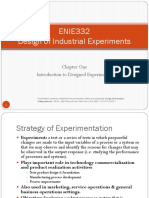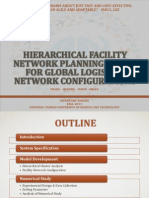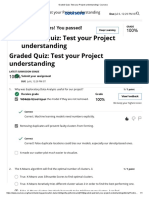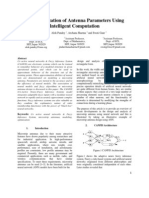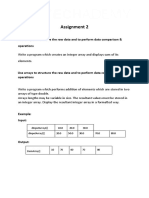ERT427
faiq@unimap.edu.my
ERT427
Design of Experiment
Lecture 1: Introduction
�ERT427
faiq@unimap.edu.my
Chapter 1: Introduction
STRATEGY OF EXPERIMENTATION
TYPICAL APPLICATIONS OF
EXPERIMENTAL DESIGNS
BASIC PRINCIPLES
GUIDELINES FOR DESIGNING
EXPERIMENT.
�ERT427
faiq@unimap.edu.my
STRATEGY OF EXPERIMENTATION
Experiment to discover!
Definition - a test or series of tests in which purposeful
changes are made to the input variables of a process or
system to observe and identify the reasons for changes
observed in the output response.
Engineering - important in new product design,
manufacturing process development and process
improvement.
Objective - to develop robust process, a process affected
minimally by external sources of variability
�ERT427
faiq@unimap.edu.my
EXAMPLE
A metallurgical engineer interested in studying the effect of
two different hardening processes, oil quenching and
saltwater quenching on aluminum alloy.
Objective: to determine which quenching solution produces
the max hardness on alloy.
As we consider this experiment, a number of important
questions come to mind. For example:
Are these two solutions the only quenching media of
potential interest?
Are there any other factors that might affect hardness
that should be investigated?
and ant other questions that relevance to the
objective of the experiments.
�ERT427
faiq@unimap.edu.my
STRATEGY OF EXPERIMENTATION
In any experiment, methods of data collection has
adversely affected the conclusion that can be drawn from
the experiment.
E.g: comparison of solution must be done at constant heat.
�ERT427
faiq@unimap.edu.my
STRATEGY OF EXPERIMENTATION
Process combination of machines, methods, people
and other sources that transforms some input (often a
material) into an output that has one or more observable
response.
�ERT427
faiq@unimap.edu.my
STRATEGY OF EXPERIMENTATION
Possible Objectives:
Determining,
1. Which variables are most influential on output y
2. Where to set the influential xs so that y is almost always
near to desired value
3. Where to set the influential xs so that variability in y is
small
4. Where to set the xs so that effects of uncontrollable
variables, zs are minimum
�ERT427
faiq@unimap.edu.my
STRATEGY OF EXPERIMENTATION:
The general approach to planning and conducting
experiment:
1)
BEST GUESS APPROACH
- Frequently used
- Often works well since the experimenters have a
great deal of technical or theoretical knowlegde of the
system and practical experience.
- However, 2 disadvantages:
- Required long time if initial guess is
incorrect or inaccurate.
- No guarantee that the best solution has
been found.
�ERT427
faiq@unimap.edu.my
STRATEGY OF EXPERIMENTATION:
2) ONE-FACTOR-AT -A-TIME
- Extensively used.
- Consist of selecting a starting point or baseline set of
levels, for each factor, then successively varying each
factor over its range with the other factors held constant
at baseline level.
- Example: Some of the factors that might affect golf
score are;
1.
Type of driver used (oversized or regular sized)
2.
Type of ball used (balata or 3 piece)
3.
Mode of travel (walking or riding)
4.
Type of beverage while playing (water or beer)
�ERT427
faiq@unimap.edu.my
- Series of graph are constructed
- interpretation of graphs above? ?
- Major disadvantage: fails to consider any interaction between
factors, so it is less efficient if interaction existed.
*What is interaction?
the failure of one factor to produce the
same effect on the response at different levels
of another factor (Fig. 1-3)
�ERT427
faiq@unimap.edu.my
STRATEGY OF EXPERIMENTATION:
3) FACTORIAL
- correct approach to deal with several factors.
- factors are varied together, instead of one at a time.
- enable the experimenter to investigate the individual
effects of each factor (or main effects) and identify any
interaction.
- EXAMPLE: Consider, a golf experiment with 2 factors of
interest;
a) type of driver
b) type of ball
�ERT427
faiq@unimap.edu.my
From Fig. 1-4,
both factors at two levels
All possible combinations are used
Geometrically, the 4 runs form the
corner of the square.
22 factorial design
(2 factors, 2 levels )
If have 8 rounds of golf to investigate, experimenter can
play 2 rounds of golf at each combination of factor levels
- replicate
�ERT427
faiq@unimap.edu.my
From the experimental data shown in Fig. 1-5 below (run twice), we
can calculate the effects.
1)
Driver effect
�ERT427
2) Ball effect
Ball effect
88 91 92 94 88 90 93 91
4
4
0.75
3) Ball- driver interaction effect
Ball driver interactio n effect
92 94 88 90 88 91 93 91
4
4
0.25
From calculation, driver effect is larger than either
the ball effect or the interactions.
faiq@unimap.edu.my
�ERT427
faiq@unimap.edu.my
Factorial design makes the most efficient use of
experimental data.
Extension of factorial design: 23, 24.2k, with k=2,3,4.
For 23 factorial design:
8 combinations (represented by each corner of cube)
�ERT427
faiq@unimap.edu.my
For 24 factorial design:
16 combinations (runs)
So, more factors, more experiments. At some point itll
become infeasible or impossible (if 10 factors?)
How to overcome?
Fractional factorial experiment, a
variation of the basic factorial design in which only a subset
of runs are made.
One half fraction
(8 from 16 runs)
�ERT427
faiq@unimap.edu.my
TYPICAL APPLICATIONS OF
EXPERIMENTAL DESIGNS
Important tool in engineering world to improve
performance of manufacturing process
Extensive application for development of new
processes.
Improved process yield
Reduced variability and
closer conformance to
target requirement
Advantage of early application
in process development
Reduced development
time
Reduced overall cost
�ERT427
faiq@unimap.edu.my
Experimental design also play a major role in engineering
design activities where new product are developed and
existing ones improved.
Applications in engineering design:
Evaluation and comparison of basic design
configurations
Evaluation of material alternatives
Selection of design parameters so that product will
work well under a wide variety of field condition.
Determination of key product design parameters that
impact product performance.
Advantages:
Products are easier to produce
Products that have enhanced field performance and
reliability
Lower product cost
Shorter product design & development time
�ERT427
faiq@unimap.edu.my
BASIC PRINCIPLES
Statistical design of experiment- process of planning the
experiment so that appropriate data that can be analyzed
by statistical methods will be collected, resulting in valid
and objective conclusions.
2 aspects to any experimental problem:
1) Design of experiment
Closely related!
2) Statistical analysis of the data.
Three basic principles of experimental design are:
1) Replication
Repetition of basic experiment
Obtain estimation of experimental error
More precise sample mean determination
Comparison with repeated measurement?
�ERT427
faiq@unimap.edu.my
2) Randomization
Random allocation of experimental material and the
order in which the individual runs or trials to be
performed.
Averaging out the effect of extraneous factors
Software present the experimental runs in random
order
3) Blocking
Is a design technique used to improve the precision
with which comparisons among the factors are made.
Used to reduce the variability transmitted from nuisance
factors factor that may influence the
response/output of experiment but not directly
interested.
A block is a set of homogenous experimental
condition
Example: blocking is used to reduced variability between
batches of raw materials.
�ERT427
Example: Randomization of runs from Design Expert software
faiq@unimap.edu.my
�ERT427
faiq@unimap.edu.my
GUIDELINES FOR DESIGNING
EXPERIMENT
�ERT427
faiq@unimap.edu.my
1) Recognition of and statement of problem
Important to solicit input from all concerned parties e.g
engineering, manufacturing, marketing, management,
customer etc.
Team approach
Prepare a list of specific problems or questions to be
addressed by experiment
Important to keep overall objective in mind. For example,
is this a new process? Objective: Characterization or
factor screening
a mature or characterized process ? Objective:
Optimization
Sequential approach using a series of smaller
experiments is a better strategy.
�ERT427
faiq@unimap.edu.my
2) Selection of the response variable
Response variable should provides useful info about
process under study.
Usually, average or standard deviation (or both) of
measured characteristics are used.
Gauge capability (or measurement error) is very important
average measurement value is considered in poor
condition.
Should define the response variable and measurement
methods before conducting the experiment.
�ERT427
faiq@unimap.edu.my
3) Choice of factors, level, and ranges
Potential design factors
factors that the experimenter wish to vary
Classification:
Design factors,
- selected parameters for study
held constant factors
- parameters held at specific level
allowed to vary factors
- e.g experimental units or nonhomogenous
material
- rely on randomization to balance out effect
�ERT427
faiq@unimap.edu.my
Nuisance factors
undesired factors, yet have large effects
Classification:
1)Controllable
-level can be set by experimenter
-use blocking technique
2) Uncontrollable
- Uncontrolled parameter but can be measured
- Analysis of covariance is used to compensate effect
3) Noise factors
-parameter varies naturally, uncontrol
- Find the setting of controllable design factors that minimize the
variability transmitted from noise factors (sometimes called a
process robustness study).
�ERT427
faiq@unimap.edu.my
After design factors are selected, the range and specific
level at which runs will be made are chosen.
Process knowledge, the combination of practical
experience and theoretical understanding is required to
do this.
For factor screening or process characterization, it is best
to keep the number of factor levels low (two levels works
very well) and region of interest (range) should be large.
�ERT427
faiq@unimap.edu.my
4) Choice of experimental design
Involves:
Consideration of sample size ( number of replicates)
Selection of the suitable run order for experimental
trials.
Determination whether blocking or other randomization
restrictions are involved
Several statistical software provide this phase of
experimental design, using provided info on factors, level
and ranges.
�ERT427
faiq@unimap.edu.my
5) Performing the experiment
Vital to monitor the process carefully
Coleman and Montgomery (1993) suggested running trial
runs before conducting experiment obtain info on
consistency of experimental material, a check on
measurement system, rough idea of error, a chance to
practice experiment and revise step 1-4.
�ERT427
faiq@unimap.edu.my
6) Statistical analysis of the data
Provide objective results and conclusions of experiment
Many software packages (in step 4) also provide direct
interface to statistical analysis.
involves simple graphical methods, hypothesis testing and
confidence interval estimation, residual analysis and model
adequacy checking.
Results may be presented in terms of empirical model, an
equation derived from the data that express the relationship
between response and important design factors.
�ERT427
faiq@unimap.edu.my
7) Conclusion and recommendations
From data analysis, practical conclusions can be drawn,
followed by recommendation of action.
Graphical methods in presenting the results.
Follow up runs and confirmation testing to validate the
conclusion.
�ERT427
faiq@unimap.edu.my
Always remember that experimentation is iterative.
Formulate
hypothese
Results
Perform
experiment
to
investigate
Major mistake to design a single, large, comprehensive experiment
at the start of a study.
A successful experiment requires knowledge of important factors,
the range and level to use and proper units of measurement.
�ERT427
faiq@unimap.edu.my










